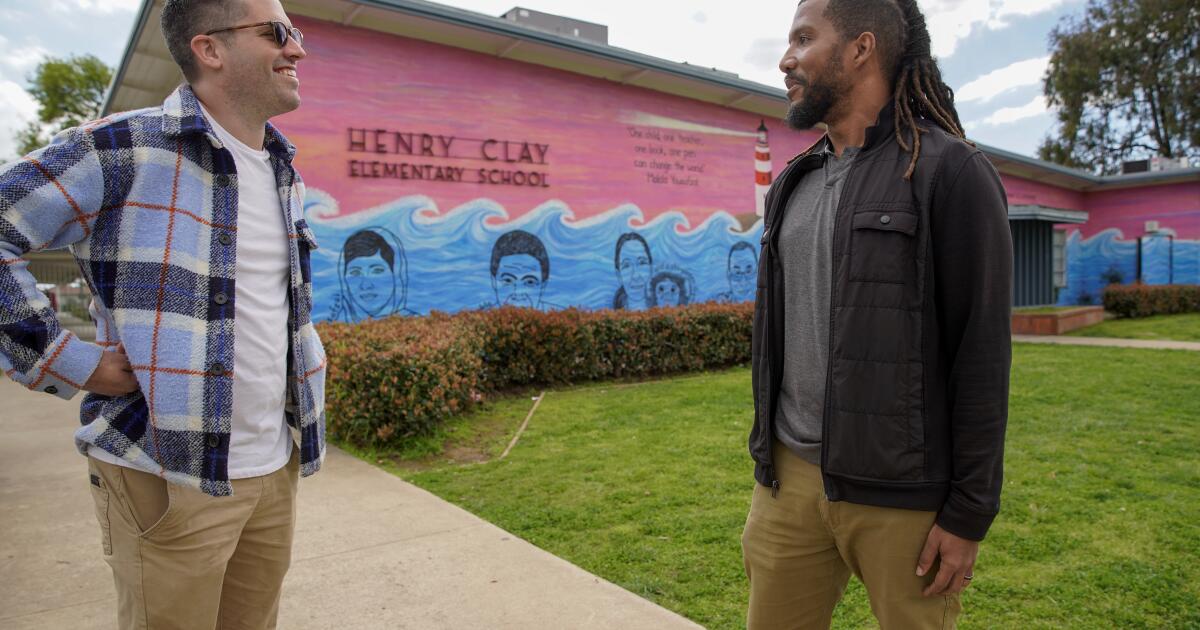
For more than a year, parents at Henry Clay Elementary in Rolando have been asking San Diego Unified to rename their children’s school.
They don’t want their school named after Henry Clay, the U.S. statesman during the decades leading up to the Civil War who owned at least 122 enslaved people and spearheaded controversial legislation that preserved slavery in the South in an effort to stave off civil war.
“There’s an obvious understanding that this is someone whom the school should not be proud of. But his name is there,” said Jerrod Tucker, a Clay Elementary parent who has helped lead a renaming effort that involves parents, school staff and community members.
Parents also hope to rename the city-owned Clay Neighborhood Park, next door to the school.
The effort is one of several around the district that parents, students and community members have launched in recent years to remove the names of historic figures now widely understood to have perpetuated racism in the U.S. In 2021 the district renamed Serra High to Canyon Hills High and renamed Lindbergh/Schweitzer Elementary to Clairemont Canyons Academy.
San Diego Unified officials agreed to rename Clay Elementary. An anonymous district committee met behind closed doors and came up with a new name they recommended to the school board: Rolling Hills Leadership Elementary, to reflect the topography of the neighborhood.
But the parents who initiated the renaming effort have concerns about transparency, and about how the name was ultimately chosen by an anonymous district committee that met behind closed doors.

Community members asked San Diego Unified to change the name of Henry Clay Elementary School — named for a 19th-century statesman and slave owner who spearheaded controversial legislation to preserve slavery. San Diego Unified recently withdrew an agenda item to rename it following complaints about the proposed name.
(Nelvin C. Cepeda / The San Diego Union-Tribune)
They also say the new name misses the point. Wanting a “restorative” name, they had proposed those of four Black women and are upset those lost out to a name the district has described as “neutral.”
The school board was supposed to vote on the name change at its regular meeting last Tuesday. Instead, the district pulled the name change from the agenda and is revisiting the process, officials said.
“We want to hear everyone’s voices. We don’t want anyone to feel they didn’t have enough opportunity to have input or have a dialogue,” said district facilities spokesperson Samer Naji.
‘A message was being sent’
Clay, born in 1777, represented Kentucky in the House of Representatives and the Senate, co-founded the Whig Party and served as speaker of the House and secretary of state.
But he is perhaps best known for spearheading the Missouri Compromise of 1820 and the Great Compromise of 1850, two controversial packages of legislation intended to prevent Southern secession and stave off civil war.
While some have credited Clay’s work with keeping the country together, if only temporarily, others have criticized his policy for drawing a dividing line through the country, allowing slavery to persist and catering to slave owners by, for example, increasing punishment for runaway slaves and those who helped them escape.
He also resisted a lawsuit by Charlotte Dupuy, one of the people he enslaved, as she sued him for her family’s freedom, based on a previous enslaver’s promise of freedom. She lost her case, and Clay had her jailed for refusing to return to his estate.
Some parents at his namesake school in San Diego point to what they see as racism not only in Clay’s history but in the roots of Clay Elementary’s naming itself.
The school was built in the 1950s when Rolando was a young and developing neighborhood attracting new homebuyers, and like many other San Diego neighborhoods, Rolando developments used racially restrictive covenants that prevented people of color from buying homes.
San Diego Unified named Clay Elementary at its founding in 1957, three years after Brown v. Board of Education paved the way for the gradual desegregation of public schools. Just two years later, the district would name one of its schools Robert E. Lee Elementary.
“A message was being sent,” Tucker said.
Today Clay Elementary enrolls about 300 students, most of whom are students of color.
Transparency vs. privacy
One year ago Tucker and other parents collected more than 1,100 signatures for a petition to San Diego Unified to rename Clay.
The parents wanted to name the school after somebody students could learn about and be proud of. They proposed the names of four Black women: feminist author bell hooks, science fiction author Octavia Butler, activist poet Amanda Gorman and Bertha Pendleton, the first female and first Black superintendent of San Diego Unified.
“We felt that it wasn’t enough to just remove Henry Clay’s name. We believed that it required an equal reaction to rename this building with a name that would undo the 70 years of structural racism that Henry Clay had represented,” said Brian Jenkins, another Clay Elementary parent who has led the renaming effort.
After emailing with parents over the course of months, district officials handed the issue to San Diego Unified’s School Names Committee, which board policy charges with recommending facility names to the school board for consideration.

While the school’s name honors a slave owner, a mural on the side of the building honors Malala Yousafzai, the Pakistani activist for girls’ education.
(Nelvin C. Cepeda / The San Diego Union-Tribune)
The district has had a names committee dating back decades.
For years, district policy required the committee to have six district staff, a high school student-body president and five community members, including members representing different community or ethnic groups. The district used to publish rosters of the committee annually.
But in 2021, the school board adopted a new, shorter policy with fewer guidelines on choosing a name. The new board policy also mandates a School Names Committee and lets the superintendent decide its makeup and size.
So last year, after the Clay Elementary name change request, Superintendent Lamont Jackson appointed a names committee. That committee consists primarily of students, with some district staff and one university expert, and the school’s principal participated in its meetings to provide feedback and answer questions, district officials said.
Unlike other district advisory committees, the renaming panel’s meetings are not open to the public, and its roster and agendas are not published.
District officials said they are keeping the School Names Committee roster secret in order to protect students’ privacy, since naming schools is a controversial issue.
The district says the committee is not subject to California’s Brown Act transparency law, because it is a staff-level committee created and directed by the superintendent. The Brown Act says committees created by a formal action of a legislative body, such as a school board, are subject to meeting transparency requirements.
‘It’s insulting’
The secrecy surrounding the renaming committee has led some Clay parents to question why and how it came up with the new proposed name of Rolling Hills Leadership Elementary.
The committee had sent two surveys to Clay families and staff: one soliciting new name suggestions, then another later one asking people to pick from a list of name options that the committee proposed. The Rolling Hills idea came from the committee, not the initial community survey, officials said. The district also hosted a town hall at the school and invited the Clay parents to present.
The parents were disappointed by the survey choices the committee offered. The options included Dupuy and Pendleton but left out hooks, one of the parents’ main suggestions. And the choices all ended with “Leadership Academy,” which some parents disliked for what they saw as military connotations.
“The only way you could participate is to vote for something you didn’t actually want,” Tucker said.
“Rolling Hills Leadership Academy” got just over half of the votes in the second survey, which got 106 responses. Afterward, the district said, the committee debated whether to call the school “Elementary” or “Leadership Academy” and ultimately settled on a combination — “Leadership Elementary.”
The committee chose Rolling Hills because it got the most votes in the survey. The committee also wanted a name based on geography, rather than a person, according to the district.
“Naming it after the geography of the location takes a turn from the tradition of schools being named after individuals,” committee members stated in their rationale for Rolling Hills.
But Clay Elementary parents said the current naming committee’s decision ignores the reason they wanted the school renamed in the first place.
“When the survey that’s being sent out includes the names of four incredible people … and then you pick geography, it’s insulting,” Tucker said.
Rolling Hills is also a direct nod to the name of the neighborhood — Rolando means “rolling” in Spanish. Decades ago, when developers were building out the neighborhood, it was named Rolando because people felt Spanish names would appeal to homebuyers.
In an email, district officials told Jenkins that the committee believed Rolling Hills “pays homage to indigenous peoples by recognizing the region’s geography.”
He doesn’t agree — he said the Spanish name and its roots in land development conflict with the idea of Indigenous sovereignty.
The committee later agreed that Rolling Hills “isn’t a great way” to honor Indigenous people but still supported it because it’s a “neutral” name, according to district officials.
If and when the school board approves a new name for Clay Elementary, the school would use temporary new signage for the name until the school’s permanent signage is changed during a campus renovation scheduled for 2026.
The city of San Diego said it may consider renaming Clay Neighborhood Park to align with a new school name if the school district approves one. “The district is leading the renaming effort and has been asked to keep the city updated on its progress,” a city spokesperson said in an email.
If the school board chooses Rolling Hills, however, the city would have to consider other names. There is already a city park called Rolling Hills in Rancho Peñasquitos, the spokesperson said.






